- cardboard of a box
- scissors
- block printing ink
- flat piece of glass
- linoleum roller
- white or coloured sheets A4 size
dinsdag 12 april 2011
Printed tulips
zaterdag 26 februari 2011
Longing for spring: printing flowers!
You need:
- piece of linoleum of 12 by 12 cm
- several sorts of paper
- lino knives
- block printing ink
- flat piece of glass
- linoleum roller
- lino press
- coloured cardboard 34 by 12 cm
- scissors
- glue or stapler
Students draw one or more flowers on their piece of linoleum and cut it out. Then the flower has to be printed on three different sorts of paper. In this lesson I choose for coloured construction paper, a brown paper bag and white white woven towels from the dispenser. Cut the prints with 1 cm around. Paste or staple them on coloured cardboard. Spring can come!
Both artworks are made by students of grade 4
dinsdag 15 februari 2011
Wild flowers
You need:
- black construction paper 20 by 8 cm
- colour pencils
- tempera paint
- q-tips
- saucer
donderdag 25 november 2010
I love Holland
Made by students of grade 6
You need:
- two pieces of linoleum of 12 by 12 cm
- white drawing paper
- lino knives
- block printing ink in red and blue
- flat piece of glass
- linoleum roller
- lino press
- cardboard in red and blue
- scissors
- glue
2 pieces of linoleum, 2 colours, 8 prints
Finally use one or more of those prints to make a two colour print. This has to be done by inking piece 1 red and printing it on a blue print of piece 2. See picture below. Let students choose their best prints and let them decide how many prints they want to use for their final artwork. Cut the prints with 1 cm white aound them. Make a composition on blue or red cardboard and paste the prints with 1 cm between them.Final composition I love Holland, by Malou, grade 6
dinsdag 24 augustus 2010
A sea of flowers
- white drawing paper A4 size
- waterpaint
- brushes
- jars with water
- black permanent marker
A sea of flowers is an expression used for fields with so many flowers, that you can hardly see the end of it. Let children see examples of 'a sea of flowers'. Have you ever seen a sea of flowers yourself? Where or when?
Tell the students they are going to paint a sea of flowers, but literally! Flowers in the water, a lot of them!
Let the children directly paint their flowers, so no pencil drawing first. They use water paint and (lots of) water. Choose different colours and shapes, and paint steals and leaves too. Do not only paint in the middle of the sheet, but also at the edge so you can see half flowers. (If you choose this lesson for a group work, children should make agreements about the places their flowers will come together and the colours of the flowers).
When the flowers are ready, students paint the background with light blue waterpaint. Paint as close as possible along the flowers , but do not touche them to prevent colours from running together. Leave the work to dry. Outline the flowers with a black marker. All spots and white edges are thus concealed.
Paste all works together to create a group work: our sea of flowers!
donderdag 3 juni 2010
Poppies in the wind
- white drawing paper A4 size
- tempera paint
- puppies or pictures of puppies
- brushes
Poppies are particularly in the United Kingdom, Canada and the U.S. symbol of the First World War because they flourished exuberantly on the battlefields of Flanders. In the famous poem 'In Flanders Fields' those poppies are mentioned. At the English National Remembrance Day, poppy wreaths are laid by the queen. Not real ones actually, because poppy petals fall very quickly. Poppies in the Netherlands have no symbolic value, but they are very nice to paint! View the brought poppies or pictures of them. Discuss the features of the flower: delicate satiny petals and a dark heart that shines through the petals. Because the flowers are very light, you see them always sway in the wind. Students paint some poppies on the upper half of their sheet. Paint the steels with black paint. Draw a frame with a red pencil about 1 cm from the edge. Paste the artwork on a black background.
Artwork made by students of 9-10 years old
vrijdag 7 mei 2010
Dutch flower bulb fields
You need:
- white drawing sheet from 20 by 10 cm
- markers
- fine black marker
- ruler
- pencil
dinsdag 13 april 2010
Symmetrical flowers
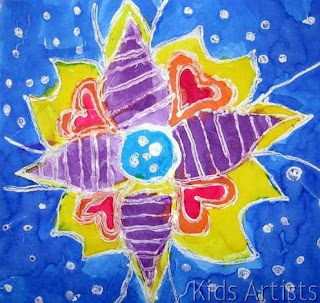
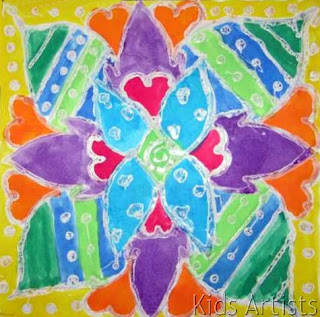

You need:
- transparent drying hobby glue
- liquid watercolour
- brushes
- white cardboard cut in squares of 20 by 20 cm
donderdag 11 maart 2010
Flowers in fingerpaint
You need:
- tempera paint
- saucers
- white drawing sheet A2 size cut in three
- coloured paper for background
- green crepe paper
- scissors
- glue
Every child gets a strip white drawing paper (A2 size, cut lengthwise in three parts). Fingerpaint your own flower. Realistic or not, it's all right. The only restriction: the stalk and leaves must be green. The flower should be as high as the sheet.
Cut the flower leaving a white edge from about 0,5 cm. Paste all flowers on a coloured background. Cut a strip of grass from crepe paper and paste this in front of the flowers.maandag 28 september 2009
Beautiful anemones
- white drawing sheet A4 size
- tissue paper in different colours
- brush
- can with water
With tissue paper you can make beautiful flowers without painting! In this lesson I chose anemones, but any flower will work. To make an anemone, fold a tissue paper three times until you have a rectangle. This rectangle has six lows now. Cut two petals out of this rectangle; this makes twelve petals totally. Six petals make one anemone. Cut petals from different colours tissue paper. Cut small and bigger ones. Take the white sheet and wet the place for the first flower with a brush. Put the petals one by one around an imaginary white circle (this is for the heart of the flower) on the wet spot. The petals will tighten themselves on the wet drawing sheet. Stich all petals this way. Overlap is allowed, working on the edge too. Cut little circles (flowerhearts) out of black tissue paper and stick them with water. The tissue paper has started 'bleeding' yet. The brighter the colour of tissue paper, the better it bleeds. Light colors bleed less. The colours of the tissue paper will blend together. If all is well, you'll see rays from the black heart into the petals. If not, wet the flowers again with a brush and water. Be careful, petals might shuffle. Let the artwork dry a little. When it's still moist a bit, pull of all petals. Your beautiful anemones are ready!
zondag 21 juni 2009
Guardian angels of the woods

- white drawing paper
- colour pencils
After telling a story about the protector of the woods, who hide themselves between the trees and bushes, children draw their own wood guardian angels. Those can be anything they think of: an angel, a ghost, a fairy or maybe even an animal. The colours should of course be natural colours: green, yellow, red, brown and mixtures of them. Hide your guardian angel between the trees, drawing a lot of leaves around it.
zondag 7 juni 2009
Waterlilies like Claude Monet

You need:
- tissue paper in different colors
- white drawing sheet (A4 size)
- glue
zondag 31 mei 2009
donderdag 28 mei 2009
A field full of sunflowers
By student of grade 4
You need:
- oil pastel crayons
- coloured ink
- brushes
- white drawing paper A4 size
- green paper for background
donderdag 21 mei 2009
Spring bulbs
You need:
- spring bulbs or pictures of them
- white drawing paper A4 size
- crayons
- wash bowl with water
- liquid watercolour
- brushes
- newspapers
- coloured paper for background





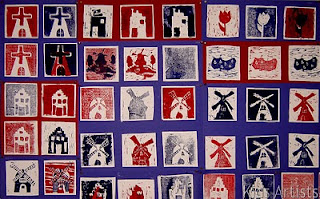
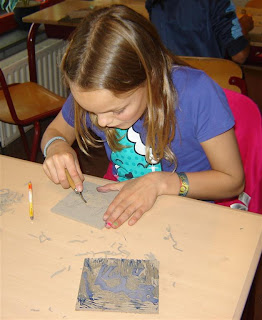
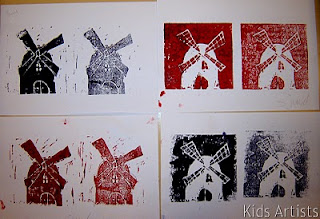
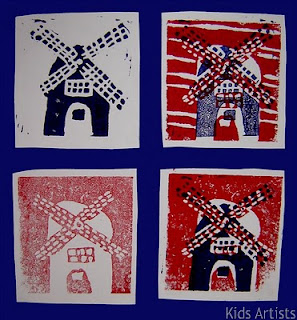
.jpg)
.jpg)



+(2).jpg)








